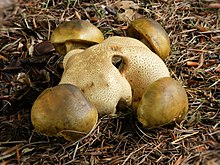| Pseudoboletus parasiticus | |
|---|---|

| |
| B. parasiticus | |
| Scientific classification | |
| Kingdom: | Fungi |
| Division: | Basidiomycota |
| Class: | Agaricomycetes |
| Order: | Boletales |
| Family: | Boletaceae |
| Genus: | Pseudoboletus |
| Species: | P. parasiticus |
| Binomial name | |
| Pseudoboletus parasiticus (Bull.) Šutara, 1790 | |
| Synonyms | |
|
Xerocomus parasiticus (Bull.) Quél., 1887 | |
| Pseudoboletus parasiticus | |
|---|---|
| Gills on hymenium | |
| Cap is flat | |
| Stipe is bare | |
| Spore print is yellow to olive | |
| Ecology is parasitic | |
| Edibility is edible but not recommended | |

Pseudoboletus parasiticus, previously known as Boletus parasiticus and Xerocomus parasiticus, and commonly known as the parasitic bolete, is a rare bolete mushroom found on earthballs (Scleroderma citrinum). Pseudoboletus parasiticus is one of the earliest-diverging lineages of the Boletaceae, after the clade comprising Chalciporus and Buchwaldoboletus.
Description
The cap is hemispherical when young, later flat, yellowish brown or darker and up to 5 cm in diameter. The flesh is pale yellow and the spores are olive. The stem is pale yellow to olive. While edible, it is not recommended to do so, due to concerns about being poisoned by its host, which is poisonous.
See also
References
- ^ Nuhn ME, Binder M, Taylor AF, Halling RE, Hibbett DS (2013). "Phylogenetic overview of the Boletineae". Fungal Biology. 117 (7–8): 479–511. doi:10.1016/j.funbio.2013.04.008. PMID 23931115.
- Phillips, Roger (2010). Mushrooms and Other Fungi of North America. Buffalo, NY: Firefly Books. p. 255. ISBN 978-1-55407-651-2.
Further reading
- E. Garnweidner. Mushrooms and Toadstools of Britain and Europe. Collins. 1994.
| Taxon identifiers | |
|---|---|
| Pseudoboletus parasiticus |
|
| Boletus parasiticus | |
This Boletales-related article is a stub. You can help Misplaced Pages by expanding it. |